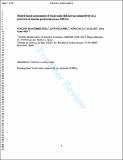Please use this identifier to cite or link to this item:
http://hdl.handle.net/10261/53310Share/Export:
 SHARE SHARE
 CORE
BASE CORE
BASE
|
|
| Visualizar otros formatos: MARC | Dublin Core | RDF | ORE | MODS | METS | DIDL | DATACITE | |

| Title: | Model-based assessment of local-scale fish larval connectivity in a network of marine protected areas |
Authors: | Basterretxea, Gotzon CSIC ORCID ; Jordi, Antoni CSIC ORCID; Catalán, Ignacio Alberto CSIC ORCID ; Sabatés, Ana CSIC ORCID | Keywords: | Coastal Connectivity Dispersal Larvae Marine protected area Mediterranean |
Issue Date: | Jul-2012 | Publisher: | Blackwell Publishing | Citation: | Fisheries Oceanography 21(4): 291-306 (2012) | Abstract: | We assessed by numerical modeling the coastal fish larval dispersion along the southern coast of Mallorca (Balearic Islands, NW Mediterranean) with the objective of determining the factors that contribute to successful recruitment. We assumed that fish larvae dispersal is mainly regulated by physical transport. Currents are mainly wind driven in this area; therefore, changes in wind forcing have a first-order impact on larval transport. The synoptic wind patterns were systematically analyzed based on self-organizing map analysis. The wind fields were clustered using a neural network pattern recognition approach into two modes, producing opposite along-shelf flow. The seasonal changes between spring and summer in the dominance of either mode modulate the along-shelf circulation, producing flow shifts under some circumstances. This variability in the wind regime was consistent throughout the 10 years analyzed (2000–2009). Using the Princeton Ocean Model (POM) and a particle-tracking algorithm, we analyzed the effect of wind-forced currents in the connectivity among near-shore habitats. We show that, at the spatial scale considered, the coastal morphology and stochastic wind forcing favor local recruitment (mean of 30% self-recruitment). Maximum transport distances of 20–30 km were typically associated with particles left to drift for 21 days. The implications for the performance of the four marine protected areas near SW Mallorca Island are discussed. Our results suggest that, although wind episodes determine the fate of short-time spawning events, on a seasonal basis, regular larval supply to coastal zones is ensured by wind stochasticity | Description: | 16 pages, 8 figures | Publisher version (URL): | https://doi.org/10.1111/j.1365-2419.2012.00625.x | URI: | http://hdl.handle.net/10261/53310 | DOI: | 10.1111/j.1365-2419.2012.00625.x | ISSN: | 1054-6006 | E-ISSN: | 1365-2419 |
| Appears in Collections: | (ICM) Artículos (IMEDEA) Artículos |
Files in This Item:
| File | Description | Size | Format | |
|---|---|---|---|---|
| Basterretxea_et_al_2012.pdf | 1,38 MB | Adobe PDF |  View/Open |
CORE Recommender
SCOPUSTM
Citations
31
checked on Apr 13, 2024
WEB OF SCIENCETM
Citations
28
checked on Feb 26, 2024
Page view(s)
330
checked on Apr 19, 2024
Download(s)
343
checked on Apr 19, 2024
Google ScholarTM
Check
Altmetric
Altmetric
WARNING: Items in Digital.CSIC are protected by copyright, with all rights reserved, unless otherwise indicated.
